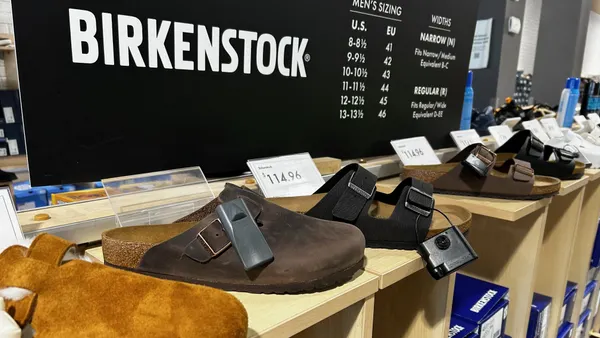Dive Brief:
-
Last year John Blackledge, analyst at investment bank Cowen & Co., made a splash by projecting that Amazon would leapfrog Macy’s to become the number one U.S. apparel retailer by 2017, and Wednesday he reiterated that stance hours after Macy's reported disastrous Q1 earnings results.
-
“In light of Amazon and Macy’s recent results, we feel more confident that Amazon will displace Macy’s as the No. 1 U.S. apparel retailer by 2017,” Blackledge said in Wednesday's research report. “Amazon’s Apparel & Accessories business is one of the key drivers of Amazon’s EGM (electronics and general merchandise) segment.”
-
Cowen calculates that Amazon's share of the U.S. apparel and accessories market has grown from 5% to 14% over the last year. "We have seen a continued shift away from more traditional retailers," Blackledge wrote, according to Bloomberg. "In the first quarter of 2016, Amazon Apparel purchasers were up ~19% year-over-year, while Apparel purchasers fell ~1% year-over-year and ~5% year-over-year at Wal-Mart and Target, respectively."
Dive Insight:
“A setback is a setup for a comeback,” Macy’s CFO Karen M. Hoguet said on a conference call with analysts Wednesday following the retailer's disappointing sales and guidance cut. She also reiterated that Macy's, which has been in the forefront of e-commerce, technology and omnichannel retail, will be continuing those efforts.
“[W]e are absolutely not pulling back our commitment to digital and omnichannel retailing,” Hoguet said, according to a transcript. “Mobile remains a very high priority, and we continue to invest. You may have seen that a leading trade publication last month ranked Macy's, Inc. as the sixth largest online retailer in America... We are continuing to see double-digit year-over-year sales increases in online sales."
But tech and e-commerce is Amazon’s foundation. Amazon also has a formidable and growing fulfillment network, ambitious delivery systems, and a host of benefits for its Prime members, like speedy shipping (often free) and an entertainment streaming service that rivals Netflix. Investing $99 upfront for Prime also helps ensure that customers go to Amazon for a host of items, and they’re likely to find them there, considering that its assortment includes some 34 million items, according to Baird Equity Research.
Blackledge noted that for the past three years, Cowen’s monthly survey of 2,500 U.S. consumers has consistently shown that Amazon is adding shoppers, while the number of Macy’s shoppers hasn’t changed. Amazon also doesn’t have the problem of physical stores, which present Macy’s and other retailers with a host of complex issues, like real estate value, maintenance, upkeep, marketing and human interactions.
But that “problem” can also be an advantage—provided that a retailer like Macy’s can take advantage of its stores, especially by deliver the kind of customer service that only humans can provide. Macy’s said Wednesday that it is also working to improve its merchandising to include more items that can’t be found anywhere else—something that Shelley E. Kohan, VP of retail consulting at RetailNext, said is a major problem for retailers like Macy’s selling ready-to-wear and other apparel, because they’re particularly vulnerable to product “sameness.”
"Going forward, collaborative marketplaces and the sharing economy will continue to challenge the traditional retail model," Kohan told Retail Dive this week. "There’s not a lot of product differentiation out there, and there are too few retailers deploying innovative strategies like exclusive collaborations with designers to break free from the pack. I see this as a problem that will continue to become more and more of an issue.”
While Amazon may be the country’s largest apparel retailer someday soon, it’s not clear that it is prepared to deal with the idiosyncrasies of apparel e-commerce—like a high rate of returns—or whether its own offerings will break out or add to that “product sameness” that Kohan talks about.














